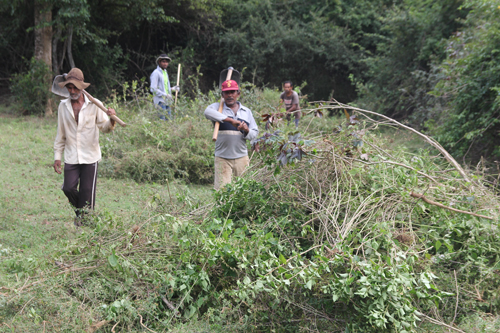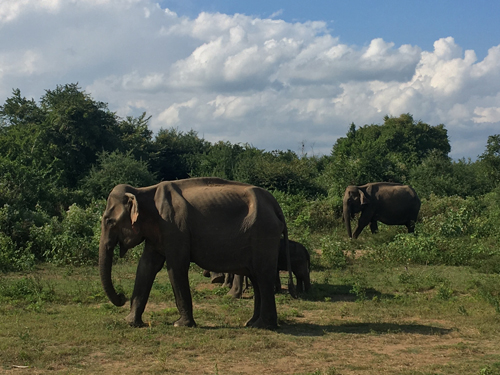Aliens are invading our national parks
Sustained campaigns needed to remove introduced species

Manual uprooting: Experimental project to eradicate two aggressive invasive species at Lunugamvehera National Park
Yesterday, May 22, was World Biodiversity Day. Sri Lanka is a globally recognised biodiversity hotspot with a number of natural sites designated as world heritage and globally important birding areas. 30% of Sri Lanka’s land area is already protected as forest or wildlife reserves. However, the viability of many such protected areas is compromised by introduced species which aggressively compete against native plants and animals.
It’s a sweltering March afternoon deep inside Lunugamvehera National Park. The rickety jeep navigated through the rough gravel roads, slowing down for troops of grey langur who, enjoying the peace and lack of visitation, had congregated on the main road for an afternoon social. We were on a monitoring mission to see the efforts of an experimental project to eradicate two aggressive invasive species from this beautiful park’s frontlines.
Along the main road were piles of manually uprooted culprits, awaiting controlled burning to stop further spread. Around these piles of dead invasives, native vegetation was already resurging, inviting deer, black naped hare and the occasional elephant to graze. In the distance, the ‘cleared area’ gave way to a ‘forest’ of invasive overgrowth. Several rows of men, mammoty in hand, were slashing away at that forest.
The project is a collaboration between the Federation of Environmental Organisations (FEO) and the Department of Wildlife Conservation (DWC) to attempt a low-cost, non-mechanised, sustainable solution involving local people as workers. The science behind this rather painstaking approach is to selectively clear the alien invasives, clearing the way for native seedlings to regenerate with rain. While using a backhoe or bulldozer may expedite clearing, this would lead to the death of both invasives and natives in the same space. Experience shows that the aggressive nature of invasive species allows it to recolonise such a clearing much faster, throttling out the indigenous species. So often, strip clearing an area with invasives can actually lead to an even more aggressive regrowth.
Uda Walawe National Park is a case study of invasive mismanagement. Uda Walawe was previously chena (shifting agriculture) land and scrub jungle that provided habitat to over 1000 elephants in the early 2000s. It became famous for elephant viewing in Sri Lanka. Over the years, the scrub jungle became mature forests and Lantana, a thorny scrub which is not consumed by wild animals, covered its grasslands. Elephants seen in Uda Walawe today have poor body condition due to the lack of food in the Park. Repeated attempts to clear Lantana has only resulted in even more aggressive resurgence.
In a recent seminar on invasive species, Ranjan Marasinghe of the DWC said that almost all national parks have some form of invasive issue from Horton Plains at the roof of the country to Bundala at the dry south-eastern corner. The type of plants that have become invasive in different parks vary with climate, physical conditions and management efforts. For example, Minneriya and Kaudulla which are seasonally inundated and provide rich feeding grounds for elephants during drought are invaded by Agada, while Lantana camera is the invasive species mostly commonly found in parks with open scrubland- Lunugamvehera, Uda Walawe, Tabbowa etc. Prosophis juliflora or Kalapu Andara is a woody tree that has spread in the coastal plains and is fiercely invading Bundala, Tabbowa and the outskirts of Wilpattu, Yala etc.
Introduced species, aliens as we call them, are those not found naturally in Sri Lanka. They could have been introduced for a purpose (agricultural/livestock/landscaping) or accidentally entered the country by sea or air through cargo or agricultural imports. Not all become invasive. According to Dr. Enoka Kudavidanage of the University of Sabaragamuwa, the lead scientist of the Lunuganvehera project, plants (and animals) that turns invasive have characteristics that make them survivors and fighters. They can thrive under conditions that other plants find inhospitable. They can usurp milder species and take their space, kill or inhibit native plants by excreting toxins and they can fix nitrogen and make their own growth more robust whereas native plants do not have these advantages.

Dire consequence of invasive spread: Emaciated elephants in Uda Walawe. Pic by Manadilani Daluwatte
At first glance, it’s hard to imagine that our national parks are in such a state. Many look green and lush, but green cover does not make a forest, says Dr. Kudavidanage. A lush growth of invasive species indicates a red sign on the park’s health card. Whatever species these parks are supposed to protect and conserve are being slowly choked. Herbivores will be the first to be affected when their food sources become scarce. The impact on this first step of the food chain will reverberate through the forest, slowly bringing down its ecological integrity and leaving parks unviable for conservation or tourism.
According to Marasinghe, visitation to parks makes control of invasives more difficult. Tourists do not want to see invasive control measures (mechanical or manual) as they will view it negatively against their wildlife experience. The government regularly conducts invasive control programmes, but lack of funds coupled with the extent of the problem sets back real progress in controlling these aliens.
Invasive-choked national parks will push animals to seek food outside the protected areas, leading to more conflict with humans. Dr. Sumith Pilapitiya, one of the country’s leading experts on elephant behaviour, says that invasive species spread is especially dire in parks that are primarily elephant habitat – Uda Walawe, Lunugamvehera, Tabbowa, Minneriya, Kaudulla- and this will push out even more elephants into human habitation or force starvation, as is happening in Uda Walawe. The strategy to reduce human-elephant conflict by restricting elephants to national parks and protected areas (in itself flawed due to the high number of elephants currently roaming outside protected areas) can only work if the parks themselves are in good condition with habitat and food for a large herbivore. If the parks themselves are compromised by alien species, this will lead to more and more elephants seeking survival outside its protected fences.
Carrying capacity is an important concept in conservation, Dr. Pilapitiya points out. This explains the number of elephants (or any species) that can be accommodated in a given land area. The more invasives in a park, carrying capacity shrinks. As carrying capacity shrinks, animals are pushed out into more conflict with humans. “If the parks are in a good condition, they will hold more elephants within and reduce the intensity of the conflict. Sri Lanka has become the hotbed of human elephant conflict worldwide,” Dr. Pilapitiya said.
While it seems a technical subject that does not easily create space for public intervention, all of us can support healthier and invasive free national parks. Companies like MAS Holdings lead the way in demonstrating how CSR projects can become multi-year, goal-based and science driven effort (http://responsiblefashion.org/turning-invasive-plant-waste-to-biofuel/) and have paved the way for more private sector collaboration with the DWC. Meanwhile FEO has launched a crowd funding campaign where individuals, organisations and private sector can collaborate and fund their own patch (or hectare) of invasive removal, pledging that the funds directly support unemployed local workforce around Lunugamvehera (https://feosrilanka.org/projects/project-lunugamvehera/). Others can, if sufficiently motivated, contact the DWC directly and organize invasive removal campaigns but realising this cannot be a one-off activity but a sustained effort. And we can simply all educate ourselves on the evils of these aliens and try to keep our gardens, aquariums and businesses clear of invasives.
(The writer is the former Policy Specialist, United Nations Development Programme and works as a technical advisor to environment and climate change programmes)


